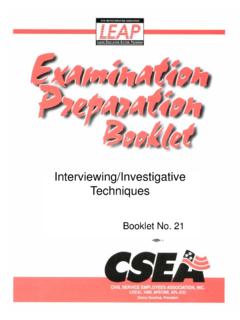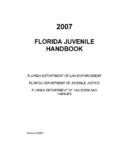Transcription of INTERVIEWING TECHNIQUES FOR HARASSMENT …
1 INTERVIEWING TECHNIQUES FORHARASSMENT INVESTIGATIONSINTRODUCTIONI. Factors That Complicate HARASSMENT InvestigationsA. One person s word against another sB. Absence of physical evidence or witnessesC. Both parties are likely to withhold information, exaggerate or Motives for a complainant to exaggerate information1. Fear that the company may not take action2. Unwarranted feelings of guilt or blame3. Revenge, advancement, rescheduled hoursII. Categories of HARASSMENT ComplaintsA. Prima Facie: Situations which, in and of themselves, clearly supportharassment (if they occurred).1. Clearly threatening or derogatory statements2. Claims of forced sexual contact3. Quid pro quo claimsB. Perceptual: Situations in which the respondent s behavior is objectionablebecause of the complainant s perception of Claims of a hostile work environment2.
2 Claims of unfair treatment3. Claims of biased performance reviews or work assignmentsIII. Investigating Person s Opinions or BeliefsA. Principle: Opinions or beliefs are not fixed in time and can change withmotivational incentives. They are therefore generally not a suitable issueupon which to make an evaluation of truth or The HARASSMENT investigation should focus on the employee s behavior1. What was said2. What was done3. What was seenOpinion: I felt degraded and put down. Behavior: I started to cry and ran out of the meeting. Opinion: He s unfair to Latinos. Behavior: I heard him tell Larry Smith to cut back on the Latinos work hoursbecause then more of them will quit. Opinion: "I'm afraid of him."Behavior: "When I was late picking up a patient s chart Dr. Williams picked upa stack of charts and threw them at me.
3 Opinion: He harasses me in the hallway. Behavior: Last Friday he yelled out, 'Hey Bitch' to me and there were all sortsof students around. IV. Goals of Complainant s InterviewA. Are the allegations factual?NOTE:The investigator should mentally rank-order the allegations fromthose which most certainly did occur to those which may contain exaggerationor fabrication. The interview of the respondent should focus on thoseallegations having the highest certainty of having Can any of the allegations be independently corroborated through aninternal investigation ?1. Witnessed statements or behaviors2. Recovered memos or E-mail messages3. Review of receipts or expense vouchersC. Establish tangible statements or actions to investigateExactly what happened?When did it happen?Where did it happen?How many times did it happen?
4 D. Suggested areas of inquiry for different types of allegationsUnwanted sexual advances: How did the complainant respond to the respondent sstatements or actions to document that the advances were unwanted? Did anyonewitness the sexual advances? Did the complainant tell any family member orcoworkers about the advances? Did the respondent s behavior continue after thecomplainant notified him of her feelings?Hostile environment: Specifically, what within the work environment does theemployee believe is hostile? How has it negatively affected the employee? Areany other coworkers bothered by this behavior? How often does it occur? Who isengaging in the hostile behavior?Consensual relationships that soured: What was done or said to terminate therelationship? Has the complainant told any coworkers about her attempts to endthe relationship?
5 How is the harasser s post-relationship behavior different thanduring the relationship?Unwanted physical contact: How do you know the physical contact was intentionaland not accidental or inadvertent? How often has it happened? Were therewitnesses? What was the complainant s verbal and behavioral response to it?Demeaning or hostile statements: What was said? In what context was thestatement made? How did the complainant respond to the statement? Who elseheard the statement? Has the respondent said this to others?V. Characteristics of the InvestigatorA. Knowledgeable about legal elements required to prove harassmentB. Knowledgeable about proper INTERVIEWING techniquesC. Someone not closely associated with the employees involvedD. A person not ultimately involved in disciplining either the complainant orrespondent1.
6 Makes it easier for both parties to tell the truth2. Protects the company from liability claims of biases during Concept: The role of the interviewer in a HARASSMENT investigation shouldbe limited to collecting factual information. It is not the interviewer s job todetermine whether or not HARASSMENT has occurred; that is the responsibility ofan attorney. Nor is it the interviewer s role to console or counsel interviewer who takes sides with either the complainant or respondentduring an investigation may not conduct a thorough investigation and may belater accused of biased Importance of Conducting a Prompt InvestigationA. Employer s obligation under EEOC guidelinesB. Improved recall on the part of the complainantC. Improved recall for witnessesD. Respondent is less likely to blame memory failureVII. Necessity of Revealing Details to the RespondentA.
7 A respondent cannot be properly questioned unless the name of thecomplainant is Ambiguous questioning of a respondent is unlikely to result in Vague questioning of a respondent may cause him to retain an attorneyearly during the The employer has a legal responsibility to protect all employee Note: Statistically, the worst day of the week to interview a respondent, ortake disciplinary action against an employee is a Friday. Disciplinary actionsoccurring on a Friday are more often disputed than those occurring earlier in theweek. Part of the reason for this is that the employer is unavailable over of the INTERVIEWING EnvironmentA. Do not interview over a desk or table (barrier)1. Barriers decrease ability of the interviewer to communicate effectively2. Barriers make identifying deceptive responses more difficultINSERT DIAGRAM OF INTERVIEW CONFIGURATIONB.
8 Establish a sense of privacyPrinciple: Privacy is the key psychological factor contributing to a successfulinterview. A truthful employee wants to experience a sense of confidentiality whendiscussing a sensitive topic. One of the major reasons a deceptive employee liesis because of the fear of being judged by others. Privacy within the environmentreduces this Closed door2. Prevent interruptions by coworkers3. Prevent interruptions by phone or beeper4. Consider conducting interview before or after normal work hoursC. Witnesses during the interview1. A witness serves as an obvious violation to privacy2. If a witness is present, place that person in an area that ispsychologically removed from the INTERVIEWING The witness should remain silent and uninvolved during the Note-taking1. Benefitsa. Slows down the pace of questions, creates periods of silenceb.
9 Documents employee s responsesc. Do not attempt to write responses down verbatim - only documentkey OVERVIEW OF INVESTIGATIVE PROCESS CHARTIX. Arranging a Meeting Between the Respondent and Complainant for thePurpose of Resolving the Adversarial environment is not conducive to truthfulnessB. Session is likely to cause anger and resentmentC. May be a satisfactory technique as a closing procedure for the harassmentcomplaint, but not to elicit further SECTION I1. The investigator should approach a HARASSMENT interview with anexpectation that both the respondent and complainant may withhold orexaggerate important One of the primary goals for the complainant s interview is to establishtangible statements or actions to The person conducting the interviews should not be in a position to makeemployment decisions or be personally familiar with either party It is important to conduct a prompt investigation once a complaint has When discussing the complaint with the respondent it is necessary to revealthe name of the complainant as well as details concerning the The INTERVIEWING environment should be private and conducted in theabsence of physical barriers.
10 If a witness is present, that person shouldremain silent and out of the subject s direct line of I EXERCISEFrom these complaints, identify key issues that should be pursued during theinterview with the complainant. Also identify documents or records that might behelpful to resolve the Joyce is complaining that her boss, Jerry, often asks her to stay late fordictation. Joyce is a single mother. By staying late she misses her usualbus which means that she is not home when her son arrives home fromgrade school. Joyce believes that Jerry is intentionally keeping her late sothat she will leave the The following memo was sent to all front desk employees: It has come toour attention that employees are discussing each other s salaries. This isconfidential information and any further such disclosures could result indisciplinary action.









